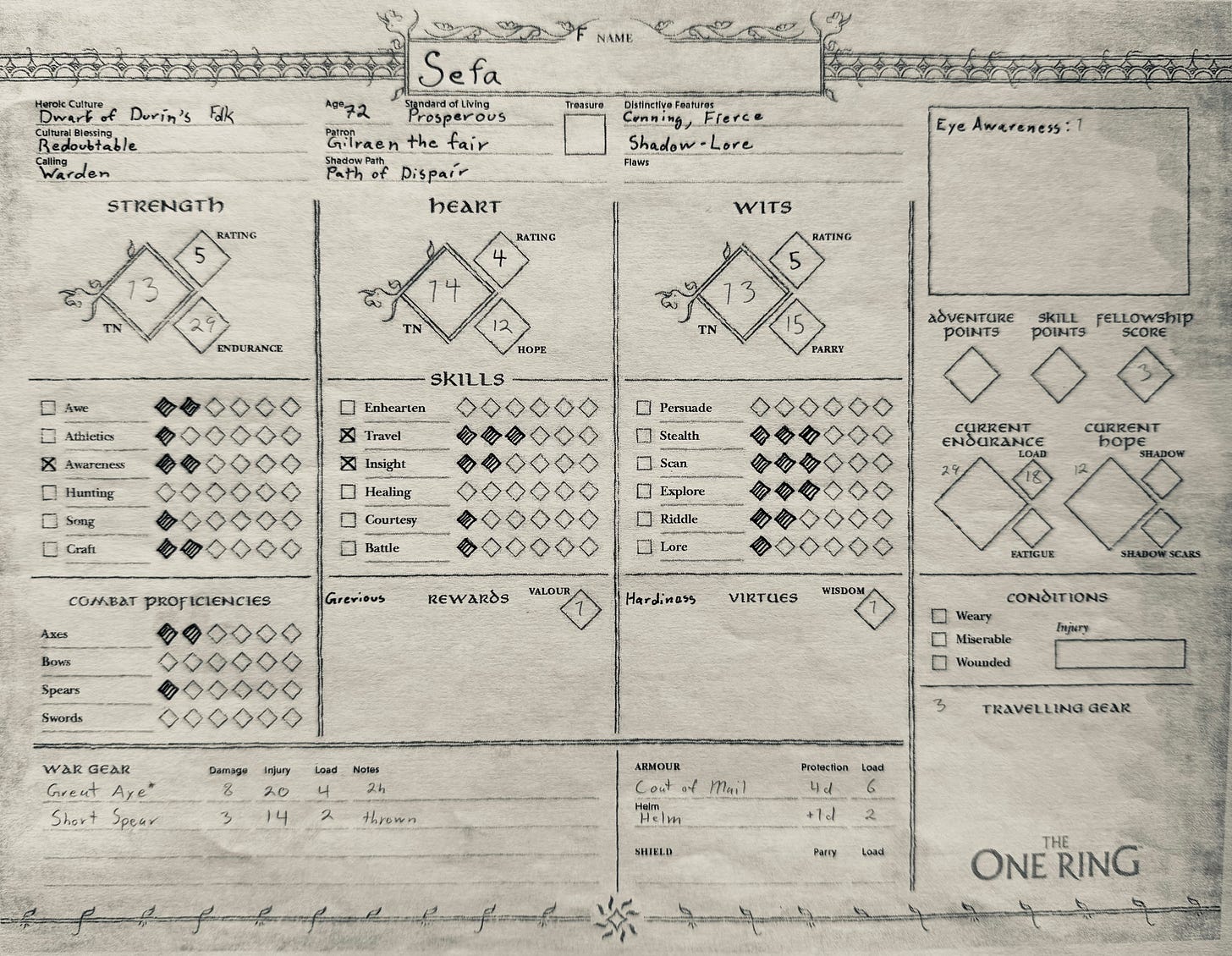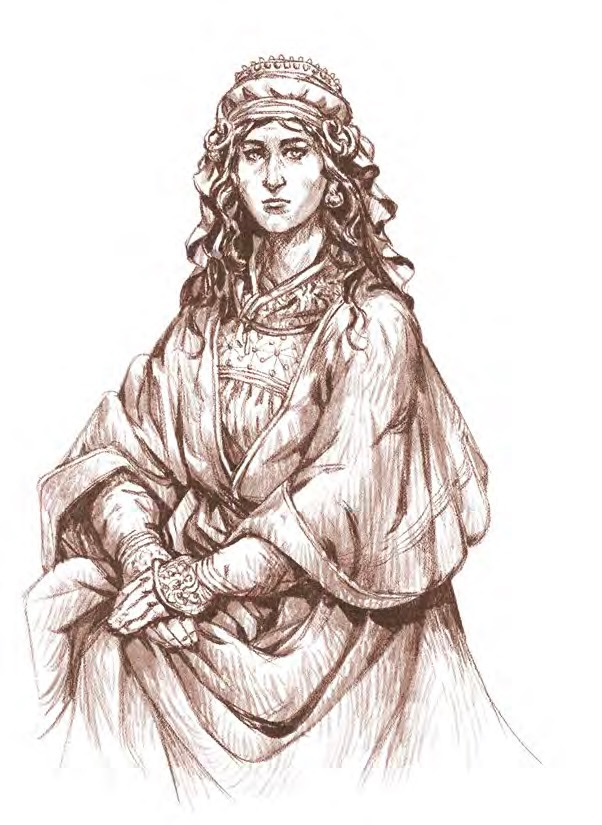The One Ring Solo Play Pt1: Creation
We're finally back! We create our two characters and give an overview of the system.
Well, it looks like I’m finally ready to start my adventure in Middle Earth, but before we get started on the adventure, we need to make some characters. First, though, I’d like to talk about the system itself.
Be sure to subscribe if you want to follow along with our adventures in Middle Earth.
If you're interested in my first solo adventure (using Shadow Dark), you can find that series here.
System & Setting
Over the past few weeks, I’ve been working through The One Ring core rulebook, and it's been more challenging than I expected to wrap my head around it. I think this is due to how different it is from any other system I’ve run. TOR (The One Ring) is very story-driven with a lot of what I call “stacking” attributes. An example of this is Hope. You can spend hope to add extra dice to your pool, and you’ll need to do this a lot. But, you can’t let your hope get too low, or you become miserable, which leads to making things even harder and needing to spend more hope. It quickly becomes a spiral.
Don’t get me wrong, I really like the system and would love to run it for a group game one day. It’s just taken me some time and multiple test games to feel semi-comfortable with it. In D&D (and most adjacent games), failure doesn’t stack or compound like that. It might make the scenario or challenge harder, but it doesn’t make your character worse at doing something. In TOR, failure, especially multiple failures, can make it harder for your character to succeed. And at least in solo play, the game is hard. I’ve run three short adventures, and my one character has died in all of them, because of this, I’ve decided to play two characters, but more on that below.
Before I jump into an Overview of the rules, I just wanted to take a moment to mention the physical book. This isn't a review, so I'm not going to go crazy, but my God, this book is beautiful. As a GM, I use mostly digital tools. The speed at which I can look things up, especially in a well-hyperlinked PDF, far outweighs my preference for physical books. But The One Ring core rulebook is so well made that I want to use it all the time. The pages are thick and enjoyable to flip through. The art is fantastic. The font is exceptional. It's hard to explain, but I think this might be my favorite physical book of any TTRPG product I've ever owned. The overall layout could use some help, and the 1-page index at the back should absolutely be better, but I like the book so much that I found myself searching the PDF for the page I need to reference and then flipping there in the actual book.
The Core Rolls
There are enough rules in TOR that I plan to talk them through as I encounter them in the actual play reports. If I tried to cover it all here, this would be a 10,000-word post, and no one wants that. The core die roll is a d12 (called the Fate Die) plus a number of d6s (called the Success Die) equal to the ranks your character has in a specific skill or proficiency. You build your die pool, roll them all, and compare the total to a Target Number (or TN). The TN is normally a static number set during character creation based on your Culture and Calling. There are ways to change your TN throughout the game, but it’s not easy. Think of it like a core ability score in D&D. Skills “roll up” under three main attributes: Strength, Heart, and Wits. Based on the situation, you may gain or lose 1-2 Success Die if the skill roll you are about to make is exceptionally easy or difficult. There are plenty of statuses or enemy abilities that change how many Success Die you roll, but we’ll talk those through as they come up.
There are a few unique features of the dice in TOR that impact gameplay. First, the Fate die has two unique symbols on it. Instead of an 11, there is the Eye of Sauron, if you roll this, the die counts as 0, and some potentially bad stuff can happen. Instead of a 12, there is Gandolf’s Rune, and this is treated as an automatic success with some extra goodies in combat.
The Success Die has an elven symbol on the 6 that indicates a special success if the overall roll was successful. You can “spend” the symbols to specify how you accomplished the task. Maybe you stealth past the guards faster than expected or learn some additional lore, something like that.
I realize that can be a lot, so to summarize what you’re typically rolling: you roll a d12 plus a number of d6s based on your skill rank. You compare this to your character’s Target Number to determine success. An 11/Eye is really bad, a 12/Rune is really good, and rolling a 6 on a d6 gives you a small advantage.
What I’m Playing
In addition to the core rules, I’m using the Strider Mode supplement, specifically built for playing TOR with one character. It's very well put together and has a lot of the things you would expect from a solo supplement. It modifies a few rules and gives you a lot of tables to roll on if you need assistance determining what's going on. It uses a specific Oracle table, what it calls a telling table, for answering reasonably simple yes-no questions.
The other major change is that it gives specific experience milestones, which I greatly appreciate. In the core rules, players earn XP based on attending a session, and that isn’t gonna work for me in solo play. I never just get to sit down for 3 hours to play solo.
As this is my first time really playing or running TOR, I decided I’m going to play through a set of adventures called Tales from the Lone Lands. It’s highly praised as a set of adventures, and I think the guidance will help keep me from feeling overwhelmed. If (and it’s a big if) the characters survive, I’ll look to have them set off into the wider world of Middle Earth and see what comes of it.

Presentation & Style
One last thing before we get to creating characters. I’m switching up the way I write my play reports. Given that TOR is such a narrative game, I don’t want to constantly jump in with rolls, even though I want to show the process. I’d also like to just try something new. So, the plan is to effectively cut each play report into two to three pieces. The first section will be written like a letter from our characters to someone else. This might be their patron, an ally, or just someone they met during their travels.
After that, I’ll do a more common report on what occurred during that section of the game, along with any major rolls. Lastly, I may have a small “GM Commentary” section about what I’m learning or things I might change. This is really just my musings as I learn a new game. Hopefully, this results in a fun, unique narrative but still lets you all in on how the game is played and the specifics of what happened.
Characters
It’s finally time to make our characters. As mentioned above, I’m going to make two. I know that Strider Mode is built specifically for one character, but I’ve decided on two for several reasons. First, my characters kept dying during the test runs, like a lot. This could just be me being unlucky or not fully understanding the game, but I would love for this adventure to last longer than two posts. Second, some of the cultures don’t make sense as solo adventurers. The best example of this is hobbits. I love hobbits (Samwise Gamgee is the best character in the main trilogy, and I will fight someone over this), but it makes no sense for them to be off adventuring alone. Since I’ll be creating the characters semi-randomly, I don’t want to have to say “no hobbits.”
Character 1: Idril
The first thing to do is determine their Heroic Culture. There are 6 of them, and I’m going to roll randomly. Our first character is going to be a Ranger of the North. This gives us their Cultural Blessing (Kings of Men: +1 to any attribute), Standard of Living (frugal), and derived stats for Endurance, Hope, and Parry.
There is a table for each culture that has six sets of attribute ratings that you can choose or roll for. I rolled and got 7 Strength, 5 Heart, and 2 Wits, and I opted to increase Heart to 6. From there, we calculate the TN for each attribute by subtracting the rating from 18. We end up with a TN of 11 for Strength, 12 for Heart, and 16 for Wits.
Our culture also gives us our ranks for each skill and lets us pick one of two skills we can make Favoured. Favored skills let you roll the Feat die twice and take the better one. Our options are Hunting or Lore, and I’m going to pick hunting as it is a Strength-related skill, and clearly, that’s what our ranger is good at.
From there, we chose our combat proficiencies. This is what weapons we are good with, I pick sword as the primary and bow as the secondary. Then we chose our Distinctive Features; these are really just “traits” that help define your character and don’t have any major mechanical benefit. I’ll go with Secretive and Swift.
Lastly, at least in the Cultural section, you get languages and a name. I also rolled randomly for gender, and we have: Idril, the Female Ranger of the North.
With the main pieces finished, we move to the calling, this is the character’s background and gives you a few extra benefits. There are six here, so I can once again roll randomly. I got Scholar on my first roll, and that makes no sense, so I rolled again and got Champion. This gives us two more skills to mark as favored, an additional feature (Enemy-Lore), and our Shadow Path (Curse of Vengeance). Shadow is a key part of TOR and represents a character's slow corruption into darkness (Isildur, Boromir, Théoden, etc). Each calling has a distinct shadow path and details what that corruption looks like if it happens.
Moving on, we get to spend 15 points to increase skills and combat proficiencies. I won’t bore you with the specific details, but I mostly use these to round things out and get Awareness, Stealth, and Lore up to 3. We then pick our starting gear (I chose a Leather Corslet for armor and a Long Sword and Bow for weapons), set our Valor and Widom to 1 each, and pick a reward for both. For Valor, I chose Cunning Make to reduce my armor load/weight, and for Wisdom, I chose Master to pick two skills and make them Favored (Healing and Stealth).
There are a few other things to do/calculate, but they don’t come into play right now, so I’ll wait till later to discuss them. The last major thing to do is pick a patron. I know I want both characters to share a Patron, so I’m going to wait until our second character is done since each patron has a few “favored callings,” and knowing both might help us decide.
Character 2: Sefa
I’m going to save the step-by-step process for our second character and just give you the results.
Sefa is a female Dwarf Warden. She is cunning, fierce, and well-versed in shadow lore, though she fights the despair brought on by her knowledge of the shadows.
Mechanically, her TNs are: 13 Strength, 14 Heart, and 13 Wits. She’s pretty well equipped for combat and reasonably well-rounded in skills.
The Patron
With a Champion and Warden in the group, I think having Gilrean, the Fair as the patron, makes sense. Her favored callings are Champion and Warden. Her agenda is to fight the enemy and defend the weak, which aligns nicely with Idril and Sefa. Here’s what the book has to say about her as a patron:
Gilraen the Fair
A woman of noble lineage, Gilraen is the mother of Aragorn, the current chieftain of the Rangers of the North and Heir of Isildur. She was quite young when she married and became a widow soon after she gave birth to her son. When that came to pass, Elrond took her and her newborn to dwell with him in Rivendell, and he raised Aragorn as a son of his own — Aragorn was called ‘Estel’ in Imladris (Sindarin for ‘Hope’) to conceal his lineage and true name from his enemies.
In the year 2965, Gilraen is not yet sixty years old. Being one of the long-lived Dúnedain, she is in the fulness of her strength of body and mind and possesses a measure of the foresight of her people. When her son left Rivendell to seek adventure a few years ago, Gilraen decided to remain in Imladris. She often leaves the Last Homely House on short trips to visit her own people in Eriador and confer with the captains of the Rangers of the North in the absence of their chieftain.
Having lost her husband Arathorn to an Orc-arrow and his father Arador to the ferocity of Hill-trolls in the Coldfells, Gilraen has experienced personally the hatred of the Enemy for her folk. She knows full well that the Dúnedain of the North and the entire region of Eriador will never be safe if evil creatures are allowed to prowl undisturbed. In the absence of her son, the chieftain, Gilraen makes sure that the Rangers don’t forsake their duty as guardians of the land of old Arnor and the borders of the Bree-land and the Shire. In this, she has found a staunch ally in the Wizard Gandalf. When she is in Rivendell, she never misses a chance to encourage the sons of Elrond to go out and hunt all monstrous creatures.
Adventurers worthy of Gilraen’s trust find themselves enjoying the respect of the Rangers of the North. When out in the wild, they can count on the help of many scouts and are provided directions to find their hidden refuges and caches of supplies.
Next Time
That wraps up our prep for the upcoming adventure. I know there was a lot of information here, but hopefully, it was informative. I’m looking forward to getting to play this game (and hopefully not just instantly die again) and excited to have you all along for the ride. Next time, we’ll pick up in Bree as Idril and Sefa hear of trouble while at the Inn of the Prancing Pony.








Really excited to follow your exploits in Middle-Earth. This was a good setup and concise introduction to the character creation process!
I've been thinking about getting the book in large part to the artwork. I have several Free League books and among them The Forbidden Lands core book is really well made and gorgeous too, but I keep hearing about The One Ring being an even more beautiful book and very well made in terms of paper quality and so on as you mention.
Best of luck, hope your characters make it more than just a few posts :)
Looking forward to see the Presentation & Style format in action! Makes a lot of sense and may meet the needs/wants of different readers.